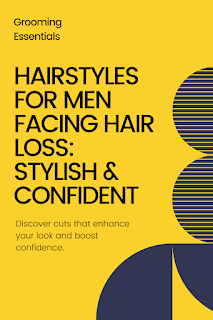While this can be confronting, losing your hair doesn’t mean you have to lose your sense of style. In fact, knowing how to match the right haircut to your face shape can make all the difference in how you feel about yourself.
Regardless of whether you’ve just started noticing a few sparse patches or you're already rocking a close buzz, choosing the right hairstyle can help disguise hair loss, frame your face better, and boost your confidence big time.
This guide will highlight how to match your hairstyle to your face shape when you are experiencing hair loss. Hopefully, you will find it a useful resource.
Before we go any further, it’s worth noting that if you're suffering from hair loss, one way to address it in the long term is to engage the services of a company like Gro Clinics.
Their expert-led hair restoration clinics offer personalised treatment plans that produce natural-looking results. For many men, they can make a serious difference.
Their expert-led hair restoration clinics offer personalised treatment plans that produce natural-looking results. For many men, they can make a serious difference.
How to match your hairstyle with your face shape
While you explore the possibilities of hair restoration, there’s still plenty you can do with just the right haircut and a bit of clever styling.Here are four steps you can take to match your hairstyle with your face shape:
Step 1: Work Out Your Face Shape
The first step in finding a hairstyle that suits you is understanding your face shape. Overall, people tend to have one of the following five main types:
Oval – If your face is slightly longer than it is wide, with balanced features, you likely have an oval shape
Round - A round face typically has full cheeks and a soft jawline, with roughly equal width and height.
Square – This shape is defined by a strong jaw, wide cheekbones, and a broad forehead.
Rectangle - Also referred to as oblong, rectangle faces are similar to square ones, just longer
Diamond – A diamond face has a narrow forehead and chin with wider cheekbones.
Oval – If your face is slightly longer than it is wide, with balanced features, you likely have an oval shape
Round - A round face typically has full cheeks and a soft jawline, with roughly equal width and height.
Square – This shape is defined by a strong jaw, wide cheekbones, and a broad forehead.
Rectangle - Also referred to as oblong, rectangle faces are similar to square ones, just longer
Diamond – A diamond face has a narrow forehead and chin with wider cheekbones.
As you explore the different face shapes and how to style for them, you might also be inspired to learn the craft yourself. Enrolling in a barbering program can teach you face-shape analysis, modern fade techniques, and strategies for working with thinning hair.
If you are unsure what your face shape is, this guide will help you.
If you are unsure what your face shape is, this guide will help you.
Step 2: Hairstyles That Flatter
Once you know your face shape, you can start choosing haircuts that complement it. Here are some good guidelines to follow:
Oval Face Shape
If you’ve got an oval face, you're in luck. This is the most versatile shape and works well with most hairstyles, including those tailored for men experiencing hair loss.
Consider a short back and sides with some length on top to keep things balanced. Buzz cuts also look great on oval faces, especially if you're leaning into a minimal, tidy look.
It's best to avoid long fringes or heavy styles that fall forward across the forehead. These can make your face appear shorter and out of proportion.
Consider a short back and sides with some length on top to keep things balanced. Buzz cuts also look great on oval faces, especially if you're leaning into a minimal, tidy look.
It's best to avoid long fringes or heavy styles that fall forward across the forehead. These can make your face appear shorter and out of proportion.
Round Face Shape
With a round face, the goal is to create the illusion of structure and angles. As this face shape can appear soft, choosing styles that add height and sharpness can work wonders.
Avoid even-length cuts all over, as they can accentuate the fullness of your face. Instead, a short fade or undercut on the sides is a better option, as it can help elongate the face visually.
Additionally, adding volume on top, whether with a spiked style or messy quiff, also helps balance the roundness, while a deep side part can add a touch of sophistication while breaking up the symmetry.
Avoid even-length cuts all over, as they can accentuate the fullness of your face. Instead, a short fade or undercut on the sides is a better option, as it can help elongate the face visually.
Additionally, adding volume on top, whether with a spiked style or messy quiff, also helps balance the roundness, while a deep side part can add a touch of sophistication while breaking up the symmetry.
Square Face Shape
Square faces are defined by their bold, angular features, with a strong jawline and broad forehead being prominent features
For this reason, crew cuts and French crops are excellent choices as they highlight those masculine features. Alternatively, a high fade can draw attention upward and away from thinning areas, and buzz cuts also work well because they showcase your strong facial structure.
Long, flowing styles can look out of place against your face’s sharp lines, so you should probably give them a miss.
For this reason, crew cuts and French crops are excellent choices as they highlight those masculine features. Alternatively, a high fade can draw attention upward and away from thinning areas, and buzz cuts also work well because they showcase your strong facial structure.
Long, flowing styles can look out of place against your face’s sharp lines, so you should probably give them a miss.
Rectangle (Oblong) Face Shape
If you have a rectangle or oblong face shape, your aim should be to avoid making the face appear even longer. Therefore, try a tapered cut with some volume on the sides and minimal height on top.
Should you not fancy that, a soft fringe can help visually shorten the face and side-swept styles or mid-length textured cuts can add width and balance.
What you don’t want is a style that adds too much volume at the crown or has very short sides. Both can exaggerate the face length.
Should you not fancy that, a soft fringe can help visually shorten the face and side-swept styles or mid-length textured cuts can add width and balance.
What you don’t want is a style that adds too much volume at the crown or has very short sides. Both can exaggerate the face length.
Diamond Face Shape
Diamond face shapes feature wide cheekbones with a narrower forehead and jaw. While rare, they can be incredibly striking.
With such a shape, you would be well advised to avoid tight fades or high undercuts that make your scalp more visible - unless you’re comfortable going very short all over.
Instead, opt for styles that add width to the top of the head, such as a textured quiff or messy side part.
With such a shape, you would be well advised to avoid tight fades or high undercuts that make your scalp more visible - unless you’re comfortable going very short all over.
Instead, opt for styles that add width to the top of the head, such as a textured quiff or messy side part.
Step 3: Disguising Hair Loss with Style
Even if you’re dealing with visible hair loss, the right grooming techniques can help you maintain a clean, confident look.
Shorter styles often reduce the contrast between thinning areas and fuller ones. Therefore, adding texture with the right cut can give the illusion of thicker hair. Moreover, if you're losing hair at the crown, consider a fade that blends smoothly to draw attention away from the spot.
It is worth noting that matte styling products are your best friend, because they create volume without that greasy, heavy feel. Just by putting a bit of product in the right place, it can make a world of difference when disguising your hair loss.
Don’t be afraid to ask your barber for advice, too. They’re trained to work with all types of hair and hair loss. They can suggest the best haircuts for thinning hair based on your individual needs.
Shorter styles often reduce the contrast between thinning areas and fuller ones. Therefore, adding texture with the right cut can give the illusion of thicker hair. Moreover, if you're losing hair at the crown, consider a fade that blends smoothly to draw attention away from the spot.
It is worth noting that matte styling products are your best friend, because they create volume without that greasy, heavy feel. Just by putting a bit of product in the right place, it can make a world of difference when disguising your hair loss.
Don’t be afraid to ask your barber for advice, too. They’re trained to work with all types of hair and hair loss. They can suggest the best haircuts for thinning hair based on your individual needs.
Step 4: Own It with Confidence
Hair loss might feel like a setback, but it doesn’t mean you can’t be stylish. In fact, finding the right hairstyle for your face shape during this time can actually help you feel more confident and in control.
A good general rule of thumb is to stick with cuts that suit your facial structure and hair texture and avoid trying to cover everything up with combovers or overly styled looks. They tend to draw more attention to thinning spots.Most importantly, remember that confidence trumps everything. A well-groomed look that is combined with self-assurance is always attractive, no matter how much hair you have.
A good general rule of thumb is to stick with cuts that suit your facial structure and hair texture and avoid trying to cover everything up with combovers or overly styled looks. They tend to draw more attention to thinning spots.Most importantly, remember that confidence trumps everything. A well-groomed look that is combined with self-assurance is always attractive, no matter how much hair you have.

















No comments